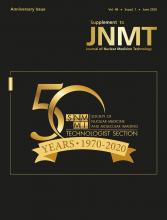Prospects for nuclear medicine and molecular imaging were bleak in the United States until fairly recently (1). The number of training programs declined, and the professional outlook and career opportunities were dismal for physicians. At the same, time nuclear medicine has been in high demand for many years and is well respected in Europe, Asia, Africa, and Oceania. We have discussed the reasons for this divergent development in detail before (1). Paradoxically, it was probably the great clinical and economic success of PET/CT imaging that led to the decline of our field in the United States. Our community was ill equipped and woefully trained in cross-sectional imaging. Conversely, and at the surface, radiologists had an easy time to adopt PET/CT by simply using FDG as a “contrast” agent. While radiologists had little interest in stand-alone PET operations, they adopted PET/CT imaging, which quickly became a major diagnostic tool in oncology. PET/CT services were provided by free-standing radiology clinics or hospital-based radiology departments.
Technologists adapted to these changes as many became certified in CT in addition to nuclear medicine. In Europe, many Asian countries, and Oceana where nuclear medicine training for physicians is far superior, things developed differently. Nuclear medicine became stronger and PET/CT remained its key technology provided by independent nuclear medicine centers.
Molecular imaging kept nuclear medicine relevant. New SPECT and PET imaging probes for cardiac, neurologic, and oncologic indications required special competence provided by our field. Nuclear cardiology remained important, but in the United States cardiology groups provided most of the services.
More recently the tide has turned. Multiple nuclear theranostic approaches have become clinical reality. In addition to the well-established radioablative treatments using 131I for benign and malignant thyroid disease, we now provide 223Ra for patients with bone metastatic disease for palliation but also for survival benefit. Azedra, targeting the norepinephrine transporter, has recently been approved by the Food and Drug Administration as a treatment for pheochromocytoma and paraganglioma (2). Last but not least, 177Lu-DOTATATE, under the trade name Lutathera (Advanced Accelerator Applications), has become a critically important component of managing Neuroendocrine tumors by targeting somatostatin receptors (3).
The greatest excitement stems from targeting the prostate-specific membrane antigen (PSMA) for diagnosis and therapy. Diagnostic studies have shown superior detection rates when compared with fluciclovine (Axumin) in patients with biochemical prostate cancer recurrence (4). Others have demonstrated high impact on managing patients at initial staging and biochemical recurrence and in those with advanced disease (5).
PSMA ligands have been labeled with 177Lu, 131I, and 225Ac for treating patients with late-stage, castrate-resistant prostate cancer. A prospective phase 2 clinical trial showed significant reductions in serum prostate-specific antigen levels in >50% of patients in response to treatment in a population with advanced disease (6). 225Ac appears to be even more effective in this setting, yet is associated with significant salivary gland toxicity. We are convinced that PSMA-targeted therapies will find their way into the clinic and will have significant positive impact on patient outcomes.
The recent advances in diagnostics and therapeutics demand changes in technologist and physician competence. If we do not adapt, others will. Our new service lines are powerful and effective. They will be provided by someone. Let’s keep them in our hands and under our control. Technologists have adapted by becoming dual x ray– and nuclear medicine–certified. This opened up new career opportunities.
Using conservative estimates, we will need more than 100 theranostics clinics that can treat more than 1,000 patients per year (1). We thus need integration with nursing and close collaboration with other clinical disciplines including medical oncology, urology, radiation oncology, endocrinology, and radiology. We need to be informed and knowledgeable about the management of those diseases to which our treatments can contribute. We should serve as treating physicians and consultants to place our therapies in the appropriate clinical context. Technologists, as the first-line contact, and physicians need to work in tandem to inform our patients from first encounter to diagnostic report or therapy administration about the purpose of tests, procedures, and treatments. In other words, our training, knowledge, and competence need to match the high relevance of the services that we can offer.
It has been a long time since our diagnostic and therapeutic service spectrum has created so much excitement. Let’s make sure to make the best of this opportunity for our patients but also for our field.










